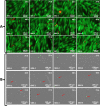Role of Graphene Oxide in Bacterial Cellulose-Gelatin Hydrogels for Wound Dressing Applications
- PMID: 37179612
- PMCID: PMC10173314
- DOI: 10.1021/acsomega.2c07279
Role of Graphene Oxide in Bacterial Cellulose-Gelatin Hydrogels for Wound Dressing Applications
Abstract
Biopolymer-based hydrogels have several advantages, including robust mechanical tunability, high biocompatibility, and excellent optical properties. These hydrogels can be ideal wound dressing materials and advantageous to repair and regenerate skin wounds. In this work, we prepared composite hydrogels by blending gelatin and graphene oxide-functionalized bacterial cellulose (GO-f-BC) with tetraethyl orthosilicate (TEOS). The hydrogels were characterized using Fourier-transform infrared spectroscopy (FTIR), scanning electron microscopy (SEM), atomic force microscope (AFM), and water contact angle analyses to explore functional groups and their interactions, surface morphology, and wetting behavior, respectively. The swelling, biodegradation, and water retention were tested to respond to the biofluid. Maximum swelling was exhibited by GBG-1 (0.01 mg GO amount) in all media (aqueous = 1902.83%, PBS = 1546.63%, and electrolyte = 1367.32%). All hydrogels were hemocompatible, as their hemolysis was less than 0.5%, and blood coagulation time decreased as the hydrogel concentration and GO amount increased under in vitro standard conditions. These hydrogels exhibited unusual antimicrobial activities against Gram-positive and Gram-negative bacterial strains. The cell viability and proliferation were increased with an increased GO amount, and maximum values were found for GBG-4 (0.04 mg GO amount) against fibroblast (3T3) cell lines. The mature and well-adhered cell morphology of 3T3 cells was found for all hydrogel samples. Based on all findings, these hydrogels would be a potential wound dressing skin material for wound healing applications.
© 2023 The Authors. Published by American Chemical Society.
Conflict of interest statement
The authors declare no competing financial interest.
Figures






References
-
- Khan M. U. A.; Haider S.; Raza M. A.; Shah S. A.; Abd Razak S. I.; Kadir M. R. A.; Subhan F.; Haider A. Smart and pH-sensitive rGO/Arabinoxylan/chitosan composite for wound dressing: In-vitro drug delivery, antibacterial activity, and biological activities. Int. J. Biol. Macromol. 2021, 192, 820–831. 10.1016/j.ijbiomac.2021.10.033. - DOI - PubMed
LinkOut - more resources
Full Text Sources
Miscellaneous

